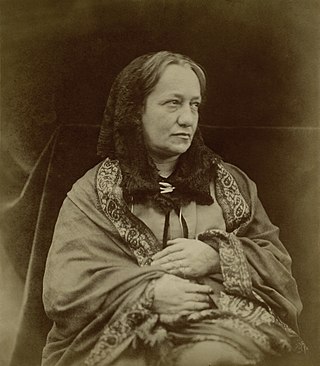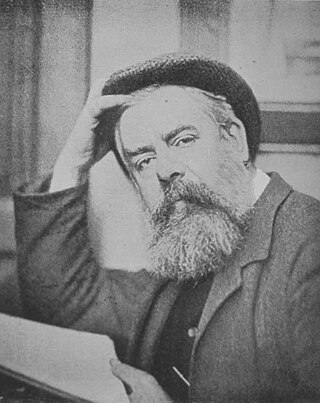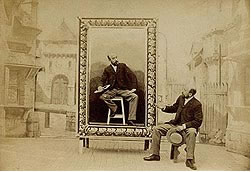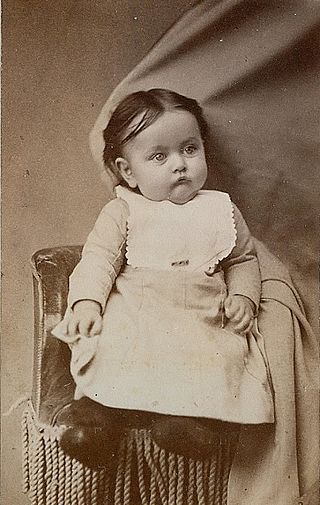
Julia Margaret Cameron was a British photographer who is considered one of the most important portraitists of the 19th century. She is known for her soft-focus close-ups of famous Victorian men and women, for illustrative images depicting characters from mythology, Christianity, and literature, and for sensitive portraits of men, women and children.

Pictorialism is an international style and aesthetic movement that dominated photography during the later 19th and early 20th centuries. There is no standard definition of the term, but in general it refers to a style in which the photographer has somehow manipulated what would otherwise be a straightforward photograph as a means of creating an image rather than simply recording it. Typically, a pictorial photograph appears to lack a sharp focus, is printed in one or more colors other than black-and-white and may have visible brush strokes or other manipulation of the surface. For the pictorialist, a photograph, like a painting, drawing or engraving, was a way of projecting an emotional intent into the viewer's realm of imagination.

Hippolyte Bayard was a French photographer and pioneer in the history of photography. He invented his own process that produced direct positive paper prints in the camera and presented the world's first public exhibition of photographs on 24 June 1839. He claimed to have invented photography earlier than Louis-Jacques Mandé Daguerre in France and William Henry Fox Talbot in England, the men traditionally credited with its invention.

Oscar Gustave Rejlander was a pioneering Victorian art photographer and an expert in photomontage. His collaboration with Charles Darwin on The Expression of the Emotions in Man and Animals has assured him a position in the history of behavioural science and psychiatry.

Combination printing is a photographic technique of using the negatives of two or more images in conjunction with one another to create a single image.

A tintype, also known as a melanotype or ferrotype, is a photograph made by creating a direct positive on a thin sheet of metal, colloquially called 'tin', coated with a dark lacquer or enamel and used as the support for the photographic emulsion. It was introduced in 1853 by Adolphe Alexandre Martin in Paris, like the daguerreotype was fourteen years before by Daguerre. The daguerreotype was established and most popular by now, though the primary competition for the tintype would have been the ambrotype, that shared the same collodion process, but on a glass support instead of metal. Both found unequivocal, if not exclusive, acceptance in North America. Tintypes enjoyed their widest use during the 1860s and 1870s, but lesser use of the medium persisted into 1930s and it has been revived as a novelty and fine art form in the 21st century. It has been described as the first "truly democratic" medium for mass portraiture.
Erotic photography is a style of art photography of an erotic, sexually suggestive or sexually provocative nature.

Henry Peach Robinson was an English pictorialist photographer best known for his pioneering combination printing - joining multiple negatives or prints to form a single image; an early example of photomontage. He joined vigorously in contemporary debates in the photographic press and associations about the legitimacy of 'art photography' and in particular the combining of separate images into one.

The carte de visite was a format of small photograph which was patented in Paris by photographer André Adolphe Eugène Disdéri in 1854, although first used by Louis Dodero.

Spirit photography is a type of photography whose primary goal is to capture images of ghosts and other spiritual entities, especially in ghost hunting. It dates back to the late 19th century. The end of the American Civil War and the mid-19th Century Spiritualism movement contributed greatly to the popularity of spirit photography. Photographers such as William Mumler and William Hope ran thriving businesses taking photos of people with their supposed dead relatives. Both were shown to be frauds, but "true believers", such as Sir Arthur Conan Doyle, refused to accept the evidence as proof of a hoax.

Baron Raimund von Stillfried, also known as Baron Raimund von Stillfried-Rathenitz, was an Austrian military officer and early professional photographer in Japan. His historical photographs of Japan following the end of the Tokugawa shogunate in the 1870s have been appreciated for their documentary and artistic value and collected in international archives.

Alexander Bassano was an English photographer who was a leading royal and high society portrait photographer in Victorian London. He is known for his photo of the Earl Kitchener in the Lord Kitchener Wants You army recruitment poster during the First World War and his photographs of Queen Victoria.

John Jabez Edwin Paisley Mayall was an English photographer who in 1860 took the first carte-de-visite photographs of Queen Victoria. He is most well known for his 1875 portrait of Karl Marx.
Thomas Richard Williams was a British professional photographer and one of the pioneers of stereoscopy.
Louis Athol Shmith was an Australian studio portrait and fashion photographer and photography educator in his home city of Melbourne, Australia. He contributed to the promotion of international photography within Australia as much as to the fostering of Australian photography in the world scene.

William H. Mumler (1832–1884) was an American spirit photographer who worked in New York and Boston. His first spirit photograph was apparently an accident—a self-portrait which, when developed, also revealed the "spirit" of his deceased cousin. Mumler then left his job as an engraver to pursue spirit photography full-time, taking advantage of the large number of people who had lost relatives in the American Civil War. His two most famous images are the photograph of Mary Todd Lincoln with the ghost of her husband Abraham Lincoln and the portrait of Master Herrod, a medium, with three spirit guides.

W. & D. Downey were Victorian studio photographers operating in London from the 1860s to the 1910s.

Frederick Hollyer was an English photographer and engraver known for his photographic reproductions of paintings and drawings, particularly those of the Pre-Raphaelite Brotherhood, and for portraits of literary and artistic figures of late Victorian and Edwardian London.

A Mysterious Portrait, also known as The Mysterious Portrait, is an 1899 French short silent film directed by Georges Méliès. It was released by Méliès's Star Film Company and is numbered 196 in its catalogs, where it is advertised as a grande nouveauté photographique extraordinaire.

Hidden mother photography is a genre of photography common in the Victorian era in which young children were photographed with their mother present but hidden in the photograph. It arose from the need to keep children still while the photograph was taken due to the long exposure times of early cameras.























